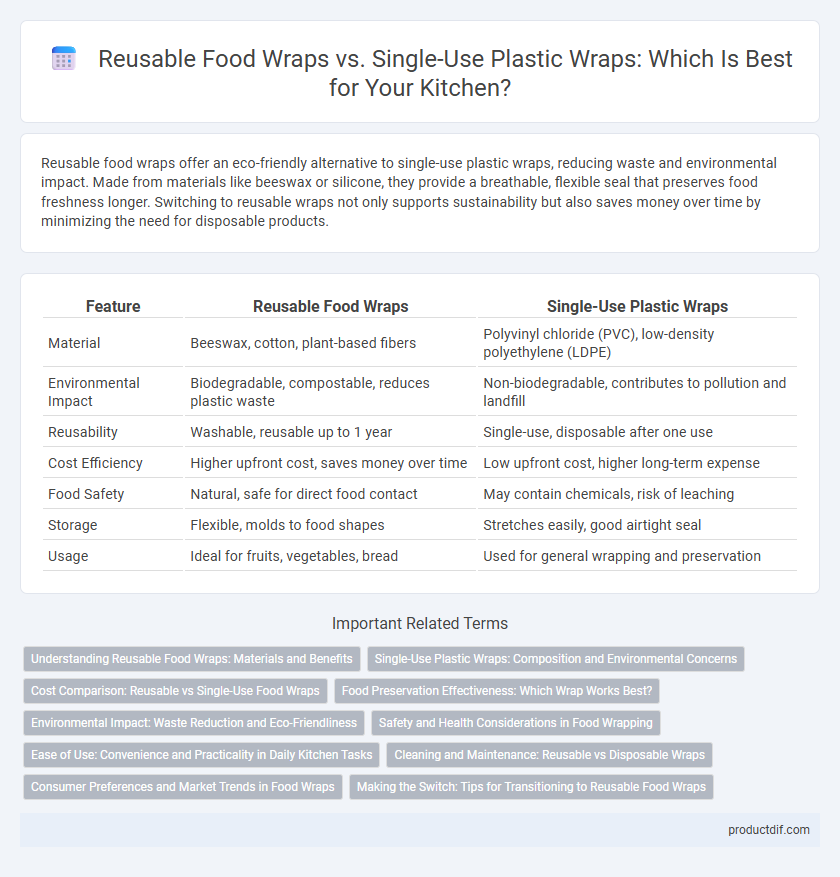Reusable food wraps offer an eco-friendly alternative to single-use plastic wraps, reducing waste and environmental impact. Made from materials like beeswax or silicone, they provide a breathable, flexible seal that preserves food freshness longer. Switching to reusable wraps not only supports sustainability but also saves money over time by minimizing the need for disposable products.
Table of Comparison
| Feature | Reusable Food Wraps | Single-Use Plastic Wraps |
|---|---|---|
| Material | Beeswax, cotton, plant-based fibers | Polyvinyl chloride (PVC), low-density polyethylene (LDPE) |
| Environmental Impact | Biodegradable, compostable, reduces plastic waste | Non-biodegradable, contributes to pollution and landfill |
| Reusability | Washable, reusable up to 1 year | Single-use, disposable after one use |
| Cost Efficiency | Higher upfront cost, saves money over time | Low upfront cost, higher long-term expense |
| Food Safety | Natural, safe for direct food contact | May contain chemicals, risk of leaching |
| Storage | Flexible, molds to food shapes | Stretches easily, good airtight seal |
| Usage | Ideal for fruits, vegetables, bread | Used for general wrapping and preservation |
Understanding Reusable Food Wraps: Materials and Benefits
Reusable food wraps are typically made from natural materials like beeswax-coated cotton, silicone, or plant-based fibers, providing an eco-friendly alternative to single-use plastic wraps. These wraps offer breathable, flexible coverage that helps preserve food freshness while reducing plastic waste and environmental impact. Their durability allows for multiple uses, saving money over time and minimizing landfill contributions associated with disposables.
Single-Use Plastic Wraps: Composition and Environmental Concerns
Single-use plastic wraps are typically made from low-density polyethylene (LDPE) or polyvinyl chloride (PVC), which provide moisture and airtight protection but are non-biodegradable and contribute significantly to plastic pollution. Their production relies on fossil fuels, resulting in high carbon emissions, while improper disposal leads to microplastic contamination in oceans and landfills. Environmental concerns emphasize the challenges of recycling these wraps due to contamination and their tendency to persist in ecosystems for hundreds of years.
Cost Comparison: Reusable vs Single-Use Food Wraps
Reusable food wraps have a higher initial cost, typically ranging from $10 to $20 per set, but their durability allows for multiple uses over months, significantly reducing long-term expenses. Single-use plastic wraps are inexpensive upfront, averaging about $2 to $5 per roll, but frequent repurchasing leads to higher cumulative costs over time. Analyzing expenditure over six months reveals reusable wraps offer better value, as they minimize waste and lower recurring spending compared to single-use options.
Food Preservation Effectiveness: Which Wrap Works Best?
Reusable food wraps made from beeswax or silicone provide superior breathability and maintain optimal moisture levels, effectively preserving food freshness longer than single-use plastic wraps that tend to trap condensation and accelerate spoilage. Studies show that reusable wraps can extend the shelf life of fruits and vegetables by up to 30% compared to plastic wraps. Their eco-friendly materials also prevent harmful chemicals from leaching into food, ensuring safer preservation.
Environmental Impact: Waste Reduction and Eco-Friendliness
Reusable food wraps significantly reduce plastic waste compared to single-use plastic wraps by minimizing landfill contributions and lowering pollution levels. Made from eco-friendly materials like beeswax or silicone, these wraps promote sustainability through biodegradability and multiple uses. Choosing reusable wraps supports waste reduction initiatives and decreases the environmental footprint of kitchenware consumption.
Safety and Health Considerations in Food Wrapping
Reusable food wraps made from natural materials such as beeswax, cotton, and jojoba oil provide a safer alternative to single-use plastic wraps by reducing exposure to harmful chemicals like BPA and phthalates commonly found in plastics. These eco-friendly wraps are breathable, preventing moisture buildup and bacterial growth, which enhances food preservation and health safety. In contrast, single-use plastic wraps can leach toxic substances into food, especially when used with hot or fatty items, posing potential health risks over time.
Ease of Use: Convenience and Practicality in Daily Kitchen Tasks
Reusable food wraps offer greater convenience in daily kitchen tasks due to their flexibility in covering various container shapes and sizes and easy cleaning with mild soap and water. Single-use plastic wraps provide quick, disposable coverage but often lack durability and can cling unevenly, making resealing food items less practical. The practicality of reusable wraps stems from their multi-use nature, reducing waste and long-term costs while maintaining effective food preservation.
Cleaning and Maintenance: Reusable vs Disposable Wraps
Reusable food wraps, often made from beeswax or silicone, require gentle hand washing with mild soap and cool water to maintain their stickiness and durability, making them an eco-friendly option with minimal environmental impact over time. In contrast, single-use plastic wraps are disposed of after one use, generating significant plastic waste and contributing to landfill overflow without any cleaning or maintenance needed. Choosing reusable wraps reduces long-term disposal costs and supports sustainable kitchen practices by eliminating the constant need to purchase and discard plastic films.
Consumer Preferences and Market Trends in Food Wraps
Consumers increasingly prefer reusable food wraps made from materials such as beeswax, silicone, and fabric due to their environmental benefits and cost-effectiveness compared to single-use plastic wraps. Market trends indicate a significant rise in demand for sustainable kitchenware, with a growing segment prioritizing eco-friendly and biodegradable options. Sales data reveal that reusable food wraps are projected to grow at a compound annual growth rate (CAGR) of over 10% in the next five years, reflecting shifting consumer values towards sustainability.
Making the Switch: Tips for Transitioning to Reusable Food Wraps
Transitioning to reusable food wraps involves gradually replacing single-use plastic wraps with eco-friendly alternatives like beeswax or silicone wraps that preserve freshness and reduce waste. Start by using reusable wraps for snacks and sandwich storage, then expand to covering bowls and wrapping produce, ensuring proper cleaning with mild soap and air drying. Incorporate mindful storage practices, such as keeping wraps in a dry, cool place, to extend their lifespan and maximize sustainability benefits.
Reusable Food Wraps vs Single-Use Plastic Wraps Infographic

 productdif.com
productdif.com